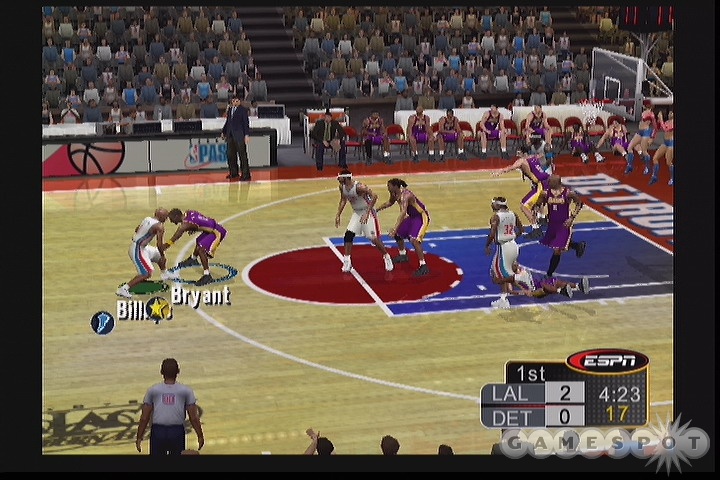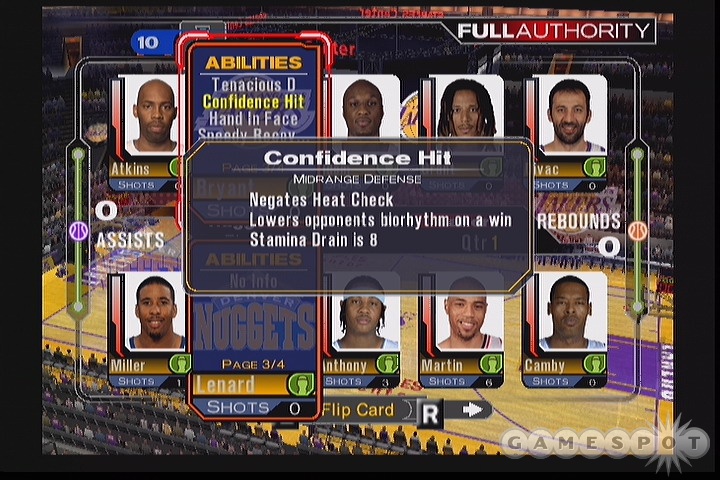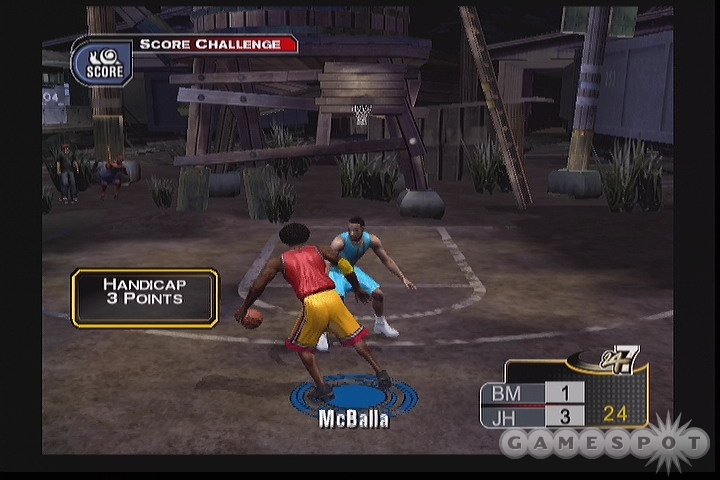Like its football and hockey brethren, which arrived earlier this year, ESPN NBA 2K5 has shipped to stores at a bargain price of $20. And, once again, developer Visual Concepts has delivered a product that resembles anything but a budget game. ESPN NBA 2K5 delivers a fantastic simulation-style basketball experience that is graphically appealing and chock-full of content.

The basic gameplay mechanics in ESPN NBA 2K5 have been tweaked to a great degree. This is most evident during post-play, which offers you tons of viable options. With your back to the basket, you can attempt to back in your defender, spin around him to gain an advantage, fire up a jump hook, execute a drop step with the new pro hop/drop step button (to get closer to the basket for a dunk or layup), or any combination of these. Depending on your position, you can also pro-hop laterally to free up for a look at the basket. While other games may allow you to do some of these moves, ESPN NBA 2K5's post-game play both looks and feels the most realistic in that these maneuvers can work some of the time but not all of the time. Sometimes backing in is all you need to do, while at other times, you'll get pushed off the block by your defender. Spinning into the lane may free you up, or you might whirl yourself into a double team. Getting sloppy with the drop step or pro hop can even result in a charging call, a traveling violation, or a simple loss of ball possession. Also, those familiar with last year's game will also be happy to know that blocked shots occur with much less frequency this year. As a result, the ratio of blocked shots to shooting fouls seems more realistic in ESPN NBA 2K5.
Related to the post-game is rebounding, and here the game does a good job, for the most part. When every shot goes up, you'll see a spot on the floor where the ball will hit (assuming the shot is missed). If you can position a player on that spot and jump at the appropriate time, you'll board the ball above the rim and eliminate the chance of anyone else getting it. If you're only near the spot when you jump, your chances of getting the rebound are lessened. Your momentum at the time of your jump also seems to matter, so if you're not well set or you're not at least moving in the direction of the rebound when you jump, you won't be able to get up as high as you would otherwise. You'll still see a bit of "vacuuming" from time to time--where the ball appears to get sucked into the hands of a faraway player--but for the most part, rebounding in the game looks realistic and feels intuitive.
For those of you who prefer to play while facing the basket, the developer has also done some tweaking with the "isomotion" juke system that was introduced to the series last year. In NBA 2K5, you won't get whistled for as many charging calls as in last year's game, so crossing over your defender to get to the basket is a more viable option. You can also execute spin moves and step backs to free yourself up for a jumper. Since isomotion unleashes canned, relatively lengthy animations, it's still not as intuitive to use as NBA Live's freestyle. You have to sit through the full animation to see if your player has gotten around the defender, although you can cancel the animation midway through if it appears that the defense has cut you off.
The passing game in ESPN NBA 2K5 is also mostly good. Players running out on the break or making cuts to and from the basket will catch passes in stride, and it's also possible to force a lead pass by pressing two buttons at once. Since players aren't always stopping to catch balls, the game looks more fluid overall, much like a real game of basketball. Passing in the half court, as in most basketball games, can look a little stilted sometimes, what with players throwing awkward-looking overheads. But much of the time, you'll also see players making deft bounce passes in appropriate situations or putting some air under skip passes to avoid interceptions.

Perhaps the most welcome addition to the gameplay is the inclusion of offensive playbooks for each team. Instead of running just basic isolation, post, or pick-and-roll plays, you can assign four different, more complex plays to the D pad. There are dozens of different plays in the game, and they can be as simple as having a post player flash across the lane or as complicated as having a set of staggered screens established to free up a wing player who's coming on a curl. The most important part is that the plays do work, and your artificially intelligent teammates do a good job at setting up and running through the scripts--just as they've been drawn up in the playbook. Defensively, you can also choose from different types of zones and trap plays, or you can just play a regular man-to-man D.
If we have one major complaint about the gameplay, it's that it's still rather difficult to stay in front of fast ball handlers, especially without a crouch stance for defense. This problem has been lessened to a degree in 2K5, because players now carry additional momentum. As a result, changing directions can't always be done on a dime, and getting started from a dead stop requires a split second of windup. If you pay close attention, you have a chance to step in front of the ball handler as he makes his move, but it's probably still harder than it necessarily should be. There also doesn't seem to be a huge variety of dunk animations in the game, and, as in last year's offering, your player will still sometimes pull up for short jumpers when you really want him to dunk or lay the ball in. However, the strengths of ESPN 2K5's on-court gameplay significantly outweigh its few weaknesses. As for the game's franchise mode, it's also undergone some significant changes--many of which are quite interesting, though not necessarily for the best.
The franchise mode in ESPN NBA 2K5 has been renamed "The Association," and it's gone through some major changes since last year's iteration of the game. Instead of just being given the choice to either simulate games or play through them yourself, you can "play" each game in a special mode called "full authority." In a nutshell, this turns a match into a turn-based strategy that's not unlike a card game. Twice per quarter, you're given the opportunity to issue "orders" to each member of your team on the floor, and you also get to make player substitutions. You'll assign how many shots each player gets, what kind of offense and defense each plays, and whether each player takes close-range, midrange, or long-range shots. The computer does the same, and then that "turn" is played out. After this, you're given your results, which show you highlights of what happened and tell you how many points each team scored.

One catch is that star players will have different special abilities--such as "killer j," "tenacious d," and "wily vet"--that can better your chances of scoring (or defending), but they come at the expense of stamina drain. You can also have the computer make selections for you during any turn, if you're feeling lazy, but it's often better to make selections yourself, because the computer makes odd decisions as far as its substitution patterns go. All in all, the full authority mode is an interesting and rather effective compromise between taking the time to play out every game in a season and relinquishing all control to the computer for simulating multiple game results.
What's also new is that every week you'll need to pick a training regimen for your team by deciding what aspect of the game it'll focus on in practice--whether it's passing, rebounding, free throws, or something else. You can choose how intense the workout is, and, in general, the harder you train, the more your players' skills go up. However, this increase in skill comes at the expense of player stamina, possibility of injury, and team chemistry. Chemistry is also affected by player visits to the coach. Every week, one of your players will come in for a visit with a specific concern in mind, such as team performance or playing time. You'll have a list of three answers to choose from. If you pick the "right" answer, your player leaves happy, and team chemistry goes up. If you pick the "wrong" one, he leaves unhappy, and team chemistry goes down.
While attempting to model team chemistry was a nice risk to take, the way it's implemented in ESPN NBA 2K5 seems a bit awkward and shallow, especially because your players end up coming in with the same questions over and over again. It's also strange that your choice of training regimens is tied in with how high team chemistry is. If you're the coach of the team, you should be the boss. Why should everyone feel warm and fuzzy before you're allowed to run a rebounding or conditioning drill? And, in reality, team chemistry is often more strongly correlated to wins and losses than it is to other factors. Sadly, this aspect isn't taken into account in ESPN NBA 2K5.
We also didn't like the fact that midseason training regimens seemed to cause far more injuries to players than is realistic. Almost every other week, one of our players would sprain or break something as a result of practice. In fact, we hardly encountered any game-related injuries relative to practice injuries. What makes this even worse is that injury reporting in the game is vague. It's not readily apparent if a specific injury is keeping one of your players from playing entirely or if he can still play but at a reduced efficiency. Overall, the new association mode in ESPN NBA 2K5 yields mixed results but offers a good overall experience with its interesting, new wrinkles.
The 24/7 mode introduced in last year's ESPN NBA is back, and it also sports some new tweaks. The basic structure is the same, so you create a baller, train his skills, and go up against NBA players in minigames for ranking, items, and respect. This time around, you'll be able to take your created baller online against other players, and the initial training of your player isn't quite as tedious. It's largely the same, though, so if you didn't like it last year, you're not likely to bother playing it this time around. Aside from 24/7, there is an array of street modes where you can play on a variety of different courts with relaxed NBA rules. There's also a tournament mode, which can be set up for parties.
ESPN NBA 2K5 can be played online on both platforms, and during our testing, the performance on both Xbox Live and PS2 Online was excellent. Players can participate in online leagues, check out their rankings in the ladder, or, as mentioned earlier, take their 24/7 player online to go head-to-head with other players' created ballers. In-game, each player is given three minutes' worth of pause timer, so no one will take too long making substitutions or coaching adjustments. It's also possible to execute friendly surrenders.

Graphically, ESPN NBA 2K5 continues the tradition of fine-looking sports games from Visual Concepts. The game includes a number of great, fully adjustable camera angles, including the default broadcast, chase cam, high baseline, and low baseline views. Players animate smoothly, and while there's still noticeable popping between animations from time to time, the game looks smoother and more fluid than any other basketball game. The players themselves are extremely well detailed, right down to their unique hairstyles and tattoos, which are inked over visibly sinewy muscle. All of this detail, of course, looks sharper on the Xbox, but the PlayStation 2 version is still a very solid-looking game. As far as the sound goes, ESPN offers adequate sound effects, with dynamic crowd noise but a forgettable soundtrack. Bill Fitzgerald and Hall of Fame center Bill Walton handle commentary, with ESPN sideline reporter Michelle Tafoya interjecting from time to time. While the trio has some unique things to say about the players, the overall commentary is good, but it's not great--and it can get repetitive.
Even though there are some rough edges in its franchise mode, ESPN NBA 2K5's basic gameplay mechanics are extremely well done, making the game easy to recommend to any basketball fan. It hits the mark in just about every aspect of basketball, including post-up play, rebounding, and passing. What's more, the game's available for cheap. That's an outright steal for such a deep, quality basketball game that also offers online play.
Editor's note 10/04/04: The review originally stated that players could not choose their own preferred camera angle while playing online, which is incorrect. GameSpot regrets the error.